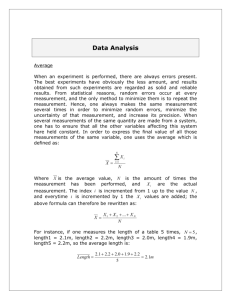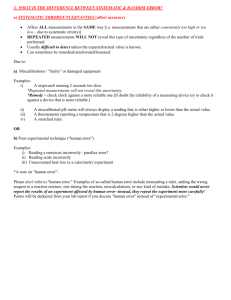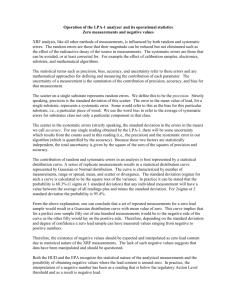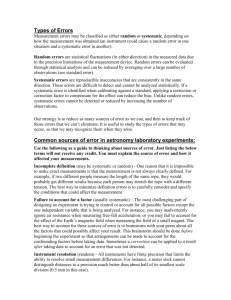Lab 1 Hookes Law CE template 2015-17
advertisement
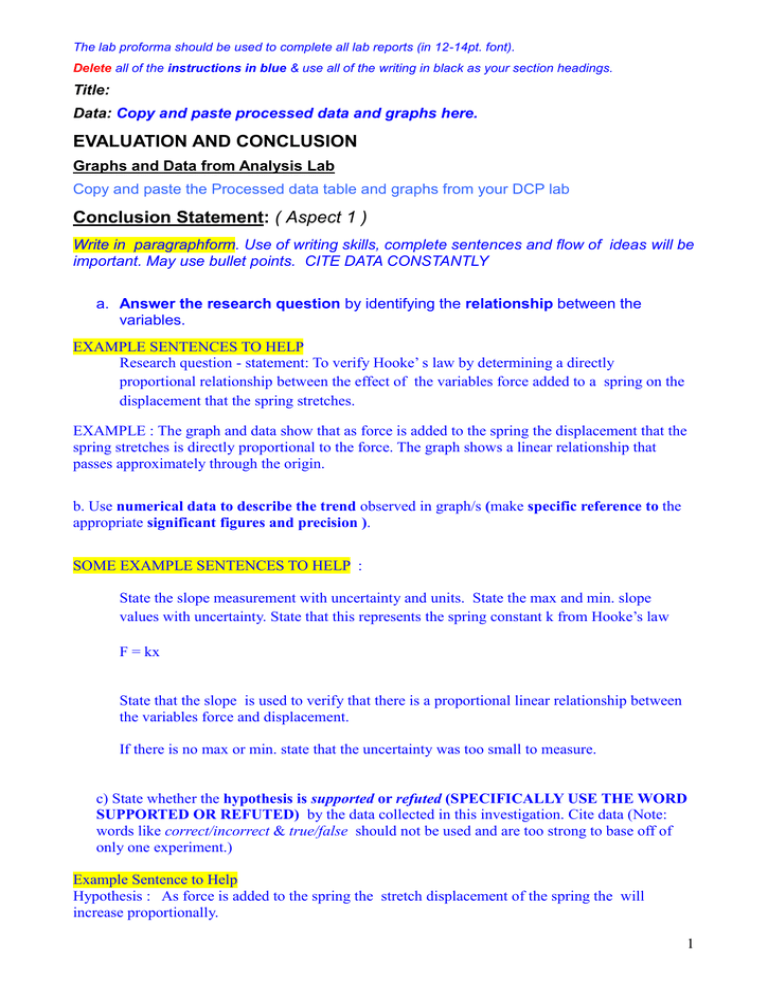
The lab proforma should be used to complete all lab reports (in 12-14pt. font). Delete all of the instructions in blue & use all of the writing in black as your section headings. Title: Data: Copy and paste processed data and graphs here. EVALUATION AND CONCLUSION Graphs and Data from Analysis Lab Copy and paste the Processed data table and graphs from your DCP lab Conclusion Statement: ( Aspect 1 ) Write in paragraphform. Use of writing skills, complete sentences and flow of ideas will be important. May use bullet points. CITE DATA CONSTANTLY a. Answer the research question by identifying the relationship between the variables. EXAMPLE SENTENCES TO HELP Research question - statement: To verify Hooke’ s law by determining a directly proportional relationship between the effect of the variables force added to a spring on the displacement that the spring stretches. EXAMPLE : The graph and data show that as force is added to the spring the displacement that the spring stretches is directly proportional to the force. The graph shows a linear relationship that passes approximately through the origin. b. Use numerical data to describe the trend observed in graph/s (make specific reference to the appropriate significant figures and precision ). SOME EXAMPLE SENTENCES TO HELP : State the slope measurement with uncertainty and units. State the max and min. slope values with uncertainty. State that this represents the spring constant k from Hooke’s law F = kx State that the slope is used to verify that there is a proportional linear relationship between the variables force and displacement. If there is no max or min. state that the uncertainty was too small to measure. c) State whether the hypothesis is supported or refuted (SPECIFICALLY USE THE WORD SUPPORTED OR REFUTED) by the data collected in this investigation. Cite data (Note: words like correct/incorrect & true/false should not be used and are too strong to base off of only one experiment.) Example Sentence to Help Hypothesis : As force is added to the spring the stretch displacement of the spring the will increase proportionally. 1 d) Identify the equation that describes the linear relationship with uncertainty, units & the correct precision for the slope and y-intercept. Equation from analysis report y-variable = (slope value ± uncertainty with units) x-variable + (y-intercept value ± uncertainty with units) Evaluating Weaknesses and Suggesting Improvements: (Aspect 2) EXPERIMENTAL WEAKNESSES AND LIMITATIONS a) Identify potential systematic errors ( GET FROM DCP report), if evident in graph/s (e.g. if the uncertainty range for the y-intercept does not include the origin when the line/curve of best fit is expected to pass through it). State the direction of systematic errors (when a systematic error is present all data points are shifted up or all data points shifted down). Cite data. b) Identify sources of random error & discuss whether they had a significant impact on the data collected ( GET FROM analysis report). Human error, parallax, etc. Cite data. USE TABLES FOR GUIDELINES ONLY. BE SURE TO DELETE AFTER FINISHING FINAL REPORT TABLES TO HELP IDENTIFY SYSTEMATIC ERROR , RANDOM ERROR FOR SIGNIFICANCE AND EFFECTS FOR ASPECT 1 ABOVE. NOTE THAT IMPROVEMENTS WILL BE ADDRESSED LATER IN ASPECT 3. Table 1: Systematic Errors Systematic Errors (if present) Significance and Direction Improvement for ASPECT 3 Are due to faulty equipment, poor calibration and/or experimental technique. A systematic error is evident when every data point deviates from the “correct” value by the same fixed amount, resulting in a random set of measurements to be spread about a value that is not the accepted value. They are reproducible inaccuracies that are consistently in the same direction. Hence, once discovered, systematic errors are predictable. They can often be detected by repeating the measurement using a different method or different apparatus and comparing the results. Discussion of significance is important i.e. by how much were all data point shifted. May need to do internet research for better methods or equipment. * See next column for examples * (Number & list in order of significance.) Direction of shift of all data points, up/above or down/below the expected result (identified when expected result is known or when curve/line does not pass through the origin when it should) Note: more trials will not reduce the effect of systematic errors. * [Examples: badly made equipment/instruments (e.g. slight movement in the support for a pendulum or a stopwatch running too fast or slow); poorly calibrated instruments; an instrument having a zero (calibration) error; using a metal ruler calibrated at 15ºC in a warmer laboratory and not allowing for thermal expansion; incorrect method or procedure used to take the measurement (e.g. error in temperature measurement due to poor thermal contact between the thermometer and the substance being measured or measuring the temperature of a small 2 test sample resulting the thermometer significantly heating the sample); always rounding down by truncating the last decimal place.] * * This table can be removed if systematic errors are not evident. Table 2: Random Errors Random Errors Significance and Effect Improvement for ASPECT 3 Are due to unpredictable variations in the performance of the instrument, the operator and/or environmental conditions. If readings of a measurement are above and below the “correct” value with equal probability, then the errors are random. Discussion of significance is important i.e. how much variation in data occurred as a result of the error. May need to do internet research for more precise measuring equipment. [Examples: human/parallax error (misreading/difficult measurements); using a less sensitive instrument when a more precise instrument that could be purchased; poorly timed actions e.g. reaction time when using a stopwatch; vibrations & air currents in mass readings; temperature variations (may also be a control variable); variation in the thickness of a surface being measured e.g. thickness of a wire.] Effect: caused variation between repeat trials (revealed in raw data table/s & by the size of error bars in graph/s); or caused variation about the curve/line of best fit (revealed in graph/s by the proximity of data points to the curve/line of best fit). Note: you can nearly always specify – repeat more trials [except when there is a high level of precision in raw data (& very small uncertainties in processed data)]. (Number & list in order of significance.) EXPERIMENTAL IMPROVEMENTS Discuss how you can improve all items in experimenta; weaknesses and limitations cited above ACCURACY, PRECISION and RELIABILITY Discuss the accuracy and precision of the data : Example sentence to get started : The RELIABILITY of the data and procedure can be seen from the LINEAR CURVE TREND found in the graph.. Cite specific graph and how the data points are close showing that the accuracy and precision of the raw data is acceptable. HOWEVER, talk about some slight INACCURACIES in the data as shown from the graph , outliers, error bars, other. Always use specific numerical data to support your statements. End with general statement , in your opinion, if the overall accuracy, precision and reliability is adequate or not. 3
